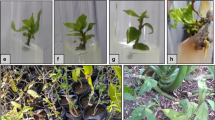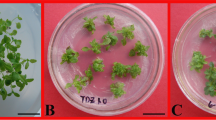Abstract
An in vitro propagation system for Artemisia judaica L., a traditional Egyptian medicinal plant, has been developed. De novo shoot organogenesis was induced by culturing etiolated hypocotyls and intact seedlings on medium supplemented with thidiazuron [N-phenyl-N′-(1,2,3-thidiazol-yl) urea] via callusing at the cotyledonary notch region. Up to 16 shoots formed per seedling cultured on a medium containing 1 µmol l−1 thidiazuron for an optimal duration of exposure of 20 days. Regenerated shoots formed roots when subcultured onto a medium containing 1 µmol l−1 indole-3-butyric acid. The regeneration protocol developed in this study provides a basis for germplasm conservation and for further investigation of medicinally active constituents of A. judaica.





Similar content being viewed by others

Abbreviations
- BAP :
-
Benzyladenine
- TDZ :
-
Thidiazuron
- IBA :
-
Indole-3-butyric acid
- NAA :
-
α-Naphthaleneacetic acid
- PGRs :
-
Plant growth regulators
References
Abdalla SS, Abu-Zagra MH (1987) Effects of cirsimaritin, a flavone isolated from Artemisia judaica, on isolate guinea-pig ileum. Planta Med 53:322–324
Boulos L (1997) Endemic flora of the Middle East and North Africa. In: Barakat HN, Hegazy (eds) Reviews in ecology: desert conservation and development. Metropole, Cairo, pp 229–260
Galal EE, Kandil A, Abdel-Latif M, Khedr T, Khafagy SM (1974) Cardiac pharmacotoxicological studies of judaicin, isolated from Artemisia judaica. Planta Med 25:88–91
Gamborg OL, Miller RA, Ojima K (1968) Nutrient requirements of suspension cultures of soybean root cells. Exp Cell Res 50:151–158
Geng S, Ma M, Ye HC, Liu BY, Li GF, Cong K (2001) Effects of ipt gene expression on the physiological and chemical characteristics of Artemisia annua L. Plant Sci 160:691–698
Hutchinson MJ, Murch SJ, Saxena PK (1996) Morphoregulatory role of thidiazuron: evidence of the involvement of endogenous auxin in thidiazuron-induced somatic embryogenesis of geranium (Pelargonium × hortorum Bailey). J Plant Physiol 149:573–579
Khafagy SM, Tosson S (1968) Crystallographic optical and chromatograph studies of judaicin, bitter principle of Artemisia judaica L.. Planta Med 16:446–449
Khafagy SM, El-Din AA, Jakupovic J, Zdero C, Bohlmann F (1988) Glaucolide-like sesquiterpene lactones from Artemisia judaica. Phytochemistry 27:1125–1128
Li H, Murch SJ, Saxena PK (2000) Thidiazuron-induced de novo shoot organogenesis on seedlings, etiolated hypocotyls and stem segments of Huang-qin. Plant Cell Tissue Organ Cult 62:169–173
Mackay WA, Kitto SL (1988) Factors affecting in vitro shoot proliferation of French tarragon. J Am Soc Hortic Sci 113:282–287
Malik KA, Saxena PK (1992) Thidiazuron induces high-frequency shoot regeneration in intact seedlings of pea (Pisum sativum), chickpea (Cicer artinum) and lentil (Lens culinaris). Aust J Plant Physiol 19:731–740
Mathe A, Laszloffy K (1991) Data to the in vitro morphogenesis of Artemisia annua L.. Acta Hortic 300:293–299
Mozzetti C, De-Donato M (1998) Micropropagation of Artemisia mutellina Vill. Acta Hortic 457:257–259
Murashige T, Skoog F (1962) A revised medium for rapid growth and bioassays with tobacco tissue cultures. Physiol Plant 15:473–497
Murch SJ, Saxena PK (1997) Modulation of mineral and fatty acid profiles during thidiazuron mediated somatic embryogenesis in peanuts (Arachis hypogeae L.). J Plant Physiol 151:183–191
Murch SJ, Saxena PK (2001) Molecular fate of thidiazuron and its effects on auxin transport in hypocotyls tissues of Pelargonium × hortorum Bailey. Plant Growth Regul 35:269–275
Murch SJ, Choffe KL, Victor JMR, Slimmon TY, Krishna Raj S, Saxena PK (2000a) Thiazuron-induced plant regeneration from hypocotyl cultures of St. John's wort (Hypericum perforatum L. cv. Anthos). Plant Cell Rep 19:576–581
Murch SJ, KrishnaRaj S, Saxena PK (2000b) Phytomaceuticals: mass production, standardization, and conservation. Sci Rev Alternative Med 4:39–43
Murthy BNS, Murch SJ, Saxena PK (1995) Thidiazuron-induced somatic embryogenesis in intact seedlings of peanut (Arachis hypogaea): endogenous growth regulator levels and significance of cotyledons. Physiol Plant 94:268–276
Murthy BNS, Murch SJ, Saxena PK (1998) Thidiazuron: a potential regulator of in vitro plant morphogenesis. In Vitro Cell Dev Biol-Plant 34:267–275
Saleh MA (1985) Volatile components of Artemisia monosperma and Artemisia judaica L. growing in the Egyptian deserts. Biochem Syst Ecol 13:265–269
Saleh NAM, El-Ghazooly SI, Abou-Zaid MM (1987) Flavonoid of Artemisia judaica, A. monosperma and A. herba-alba. Phytochemistry 26:3059–3064
Saxena PK (2001) Preface to special issue on in vitro culture of medicinal plants. Plant Cell Tissue Organ Cult 62:167
Saxena PK, Malik KA, Gill R (1992) Induction of thidiazuron by somatic embryogenesis in intact seedlings of peanut. Planta 187:421–424
Skoog F, Miller CO (1957) Chemical regulation of growth and organ formation in plant tissues cultured in vitro. In: Porter HK (ed) The biological action of growth substances. Academic Press, New York, pp 118–131
Springuel I (1997) Vegetation, land use and conservation. In: Barakat HN, Hegazy AK (eds) Reviews in ecology: desert conservation and development. Metropole, Cairo, pp 184–185
Steward FC, Mapes MO, Kent AE, Holsten RD (1964) Growth and development of cultured plant cells. Science 143:20–27
Thomas DSG (1988) The biogeomorphology of acid and semi-acid environments. In: Viles HA (eds) Biogeomorphology. Blackwell, Oxford, pp 193–221
Visser C, Qureshi JA, Gill R, Saxena PK (1992) Morphoregulatory role of thidiazuron: substitution of auxin and cytokinin requirement for the induction of somatic embryogenesis in Geranium hypocotyls cultures. Plant Physiol 99:1704–1707
Acknowledgements
The authors are grateful for the collaboration and support of staff of the St. Katherine Protectorate, Sinai, Egypt. The financial support of the Natural Sciences and Engineering Research Council of Canada is gratefully acknowledged.
Author information
Authors and Affiliations
Corresponding author
Additional information
Communicated by L.C. Fowke
Rights and permissions
About this article
Cite this article
Liu, C.Z., Murch, S.J., EL-Demerdash, M. et al. Regeneration of the Egyptian medicinal plant Artemisia judaica L.. Plant Cell Rep 21, 525–530 (2003). https://doi.org/10.1007/s00299-002-0561-x
Received:
Revised:
Accepted:
Published:
Issue Date:
DOI: https://doi.org/10.1007/s00299-002-0561-x



